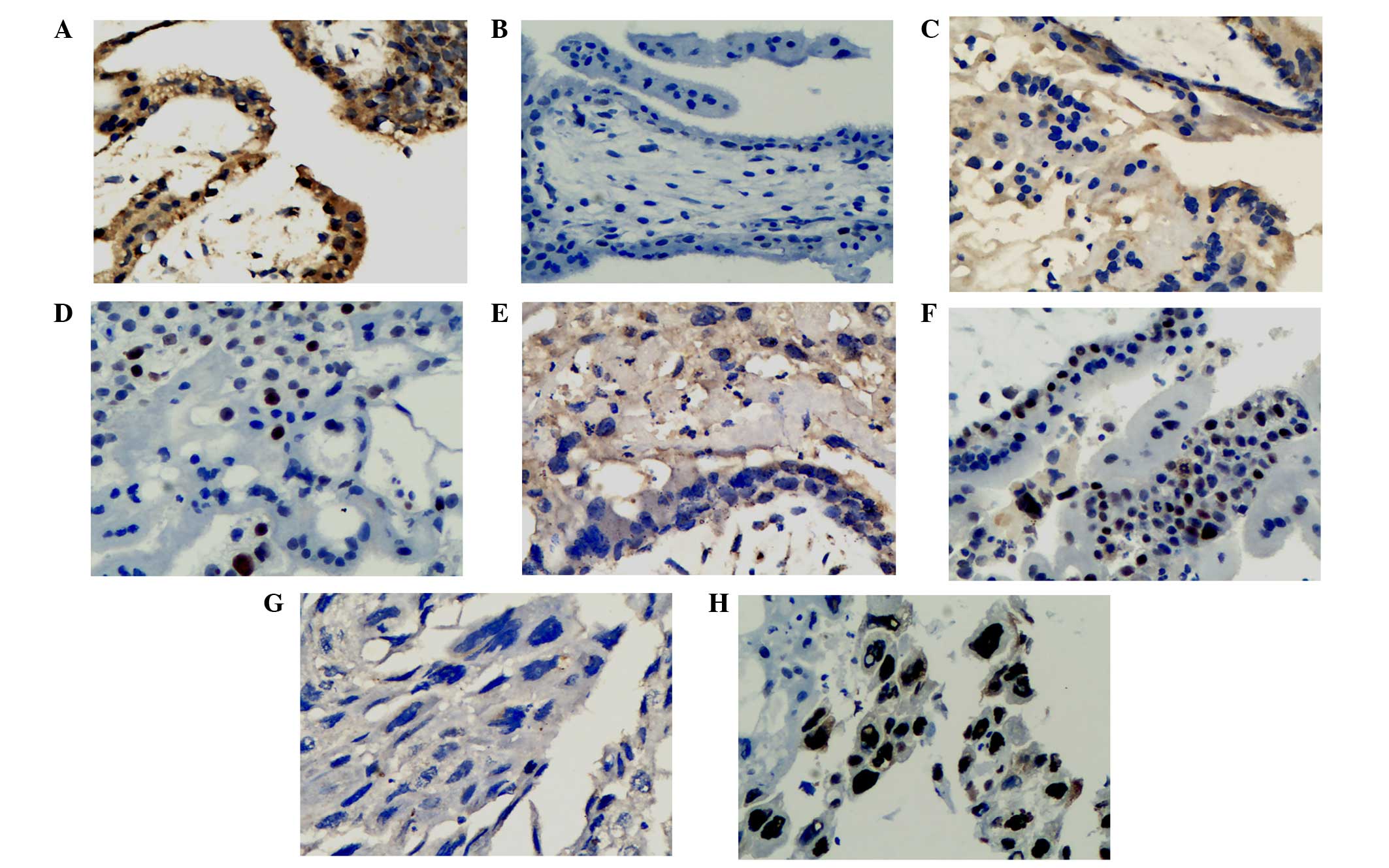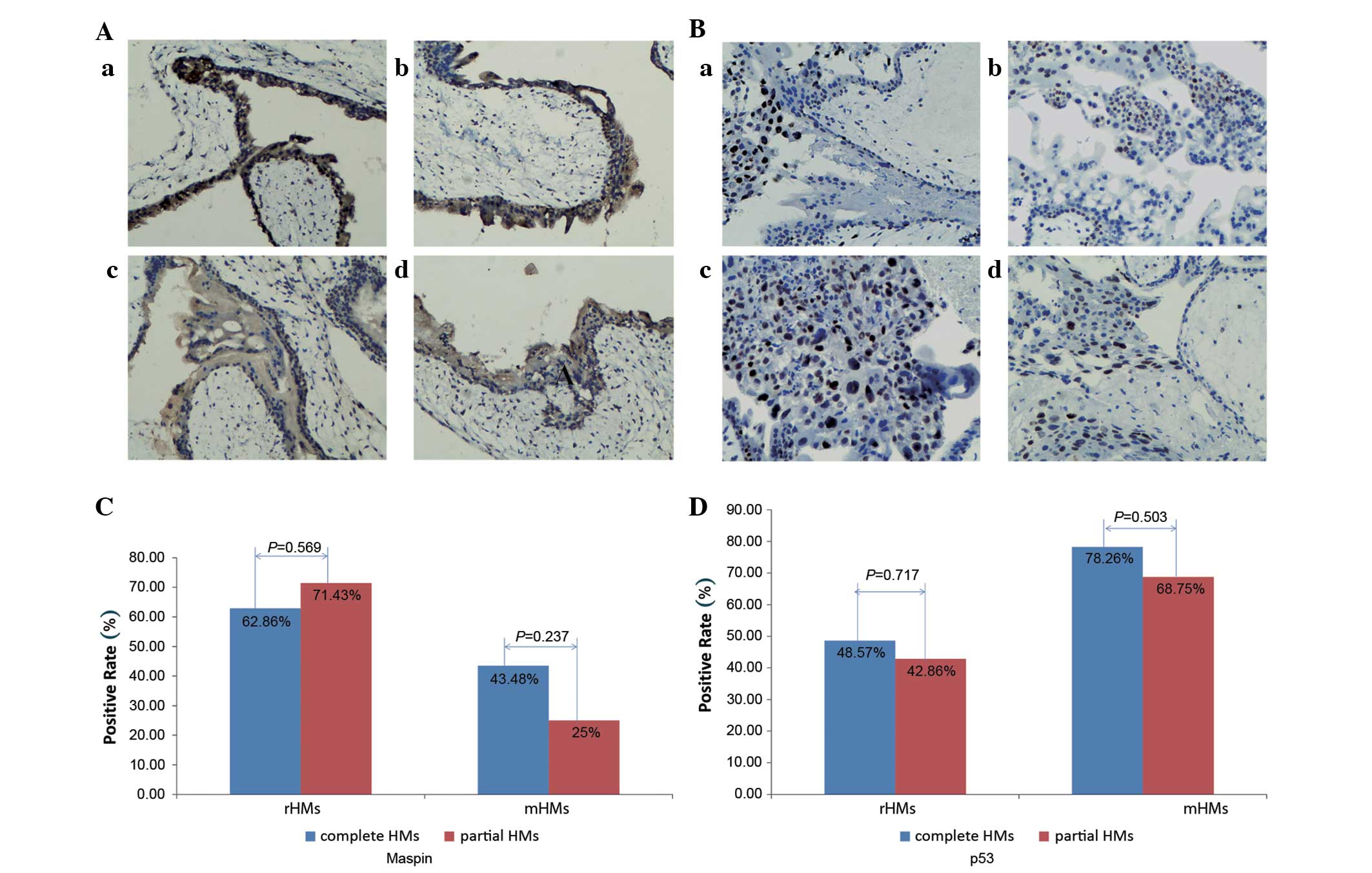|
1
|
Savage P, Williams J, Wong SL, Short D,
Casalboni S, Catalano K and Seckl M: The demographics of molar
pregnancies in England and Wales from 2000–2009. J Reprod Med.
55:341–345. 2010.PubMed/NCBI
|
|
2
|
Grimes DA: Epidemiology of gestational
trophoblastic disease. Am J Obstet Gynecol. 150:309–318. 1984.
View Article : Google Scholar : PubMed/NCBI
|
|
3
|
Bracken MB, Brinton LA and Hayashi K:
Epidemiology of hydatidiform mole and choriocarcinoma. Epidemiol
Rev. 6:52–75. 1984.PubMed/NCBI
|
|
4
|
Bracken MB: Incidence and aetiology of
hydatidiform mole: An epidemiological review. Br J Obstet Gynaecol.
94:1123–1135. 1987. View Article : Google Scholar : PubMed/NCBI
|
|
5
|
Shi YF, Li JQ, Zheng W, Chen XJ, Qiao YH,
Hao M, Zhou CW, Hu YL, Wan GM, Sha YC and Zheng X: Survey of
gestational trophoblastic disease incidence among 3.6 million
pregnancies in China. Zhonghua Fu Chan Ke Za Zhi. 40:76–78.
2005.(In Chinese). PubMed/NCBI
|
|
6
|
Ngu SF and Chan KK: Management of
Chemoresistant and quiescent gestational trophoblastic disease.
Curr Obstet Gynecol Rep. 3:84–90. 2014. View Article : Google Scholar : PubMed/NCBI
|
|
7
|
Powles T, Savage PM, Stebbing J, Short D,
Young A, Bower M, Pappin C, Schmid P and Seckl MJ: A comparison of
patients with relapsed and chemo-refractory gestational
trophoblastic neoplasia. Br J Cancer. 96:732–737. 2007. View Article : Google Scholar : PubMed/NCBI
|
|
8
|
Ie M Shih: Gestational trophoblastic
neoplasia-pathogenesis and potential therapeutic targets. Lancet
Oncol. 8:642–650. 2007. View Article : Google Scholar : PubMed/NCBI
|
|
9
|
Nguyen NM and Slim R: Genetics and
epigenetics of recurrent Hydatidiform moles: Basic science and
genetic counselling. Curr Obstet Gynecol Rep. 3:55–64. 2014.
View Article : Google Scholar : PubMed/NCBI
|
|
10
|
Zou Z, Anisowicz A, Hendrix MJ, Thor A,
Neveu M, Sheng S, Rafidi K, Seftor E and Sager R: Maspin, a serpin
with tumor-suppressing activity in human mammary epithelial cells.
Science. 263:526–529. 1994. View Article : Google Scholar : PubMed/NCBI
|
|
11
|
Khalkhali-Ellis Z: Maspin: The new
frontier. Clin Cancer Res. 12:7279–7283. 2006. View Article : Google Scholar : PubMed/NCBI
|
|
12
|
Kaplun A, Dzinic S, Bernardo M and Sheng
S: Tumor suppressor maspin as a rheostat in HDAC regulation to
achieve the fine-tuning of epithelial homeostasis. Crit Rev
Eukaryot Gene Expr. 22:249–258. 2012. View Article : Google Scholar : PubMed/NCBI
|
|
13
|
Bodenstine TM, Seftor RE, Khalkhali-Ellis
Z, Seftor EA, Pemberton PA and Hendrix MJ: Maspin: Molecular
mechanisms and therapeutic implications. Cancer Metastasis Rev.
31:529–551. 2012. View Article : Google Scholar : PubMed/NCBI
|
|
14
|
Choy B, Findeis-Hosey JJ, Li F, McMahon
LA, Yang Q and Xu H: High frequency of coexpression of maspin with
p63 and p53 in squamous cell carcinoma but not in adenocarcinoma of
the lung. Int J Clin Exp Pathol. 6:2542–2547. 2013.PubMed/NCBI
|
|
15
|
Secord A Alvarez, Darcy KM, Hutson A,
Huang Z, Lee PS, Jewell EL, Havrilesky LJ, Markman M, Muggia F and
Murphy SK: The regulation of MASPIN expression in epithelial
ovarian cancer: Association with p53 status, and MASPIN promoter
methylation: A gynecologic oncology group study. Gynecol Oncol.
123:314–319. 2011. View Article : Google Scholar : PubMed/NCBI
|
|
16
|
Wang SE, Narasanna A, Whitell CW, Wu FY,
Friedman DB and Arteaga CL: Convergence of p53 and transforming
growth factor beta (TGFbeta) signaling on activating expression of
the tumor suppressor gene maspin in mammary epithelial cells. J
Biol Chem. 282:5661–5669. 2007. View Article : Google Scholar : PubMed/NCBI
|
|
17
|
Ngan HY, Bender H, Benedet JL, Jones H,
Montruccoli GC and Pecorelli S: FIGO Committee on Gynecologic
Oncology. Gestational trophoblastic neoplasia, FIGO 2000 staging
and classification. Int J Gynaecol Obstet. 83(Suppl 1): S175–S177.
2003.
|
|
18
|
Chan HY, Siu MK, Zhang HJ, Wong ES, Ngan
HY, Chan KY and Cheung AN: Activated Stat3 expression in
gestational trophoblastic disease: Correlation with
clinicopathological parameters and apoptotic indices.
Histopathology. 53:139–146. 2008. View Article : Google Scholar : PubMed/NCBI
|
|
19
|
Zhang HJ, Xue WC, Siu MK, Liao XY, Ngan HY
and Cheung AN: P63 expression in gestational trophoblastic disease:
Correlation with proliferation and apoptotic dynamics. Int J
Gynecol Pathol. 28:172–178. 2009. View Article : Google Scholar : PubMed/NCBI
|
|
20
|
Chen RJ, Chu CT, Huang SC, Chow SN and
Hsieh CY: Telomerase activity in gestational trophoblastic disease
and placental tissue from early and late human pregnancies. Hum
Reprod. 17:463–468. 2002. View Article : Google Scholar : PubMed/NCBI
|
|
21
|
Chiu PM, Ngan YS, Khoo US and Cheung AN:
Apoptotic activity in gestational trophoblastic disease correlates
with clinical outcome: Assessment by the caspase-related M30
CytoDeath antibody. Histopathology. 38:243–249. 2001. View Article : Google Scholar : PubMed/NCBI
|
|
22
|
Rumer KK, Post MD, Larivee RS, Zink M,
Uyenishi J, Kramer A, Teoh D, Bogart K and Winn VD: Siglec-6 is
expressed in gestational trophoblastic disease and affects
proliferation, apoptosis and invasion. Endocr Relat Cancer.
19:827–840. 2012. View Article : Google Scholar : PubMed/NCBI
|
|
23
|
Li HW, Leung SW, Cheung AN, Yu MM, Chan LK
and Wong YF: Expression of maspin in gestational trophoblastic
disease. Gynecol Oncol. 101:76–81. 2006. View Article : Google Scholar : PubMed/NCBI
|
|
24
|
Cheung AN, Shen DH, Khoo US, Chiu MP, Tin
VP, Chung LP and Ngan HY: Immunohistochemical and mutational
analysis of p53 tumor suppressor gene in gestational trophoblastic
disease: Correlation with mdm2, proliferation index, and
clinicopathologic parameters. Int J Gynecol Cancer. 9:123–130.
1999. View Article : Google Scholar : PubMed/NCBI
|
|
25
|
Marioni G, Zanoletti E, Stritoni P,
Lionello M, Giacomelli L, Gianatti A, Cattaneo L, Blandamura S,
Mazzoni A and Martini A: Expression of the tumour-suppressor maspin
in temporal bone carcinoma. Histopathology. 63:242–249. 2013.
View Article : Google Scholar : PubMed/NCBI
|
|
26
|
Bai SS, Pang YC and LM T: HZ. The effect
of Maspin on malignant transformation of hydatidiform mole. Chin J
Family Planning & Gynecotokology. 03:10–13. 2011.(In
Chinese).
|
|
27
|
Seftor RE, Seftor EA, Sheng S, Pemberton
PA, Sager R and Hendrix MJ: Maspin suppresses the invasive
phenotype of human breast carcinoma. Cancer Res. 58:5681–5685.
1998.PubMed/NCBI
|
|
28
|
Zhang M, Volpert O, Shi YH and Bouck N:
Maspin is an angiogenesis inhibitor. Nat Med. 6:196–199. 2000.
View Article : Google Scholar : PubMed/NCBI
|
|
29
|
Lee DY, Park CS, Kim HS, Kim JY, Kim YC
and Lee S: Maspin and p53 protein expression in gastric
adenocarcinoma and its clinical applications. Appl Immunohistochem
Mol Morphol. 16:13–18. 2008.PubMed/NCBI
|
|
30
|
Sedic M, Poznic M, Gehrig P, Scott M,
Schlapbach R, Hranjec M, Karminski-Zamola G, Pavelic K and Pavelic
S Kraljevic: Differential antiproliferative mechanisms of novel
derivative of benzimidazo[1,2-alpha]quinoline in colon cancer cells
depending on their p53 status. Mol Cancer Ther. 7:2121–2132. 2008.
View Article : Google Scholar : PubMed/NCBI
|

















